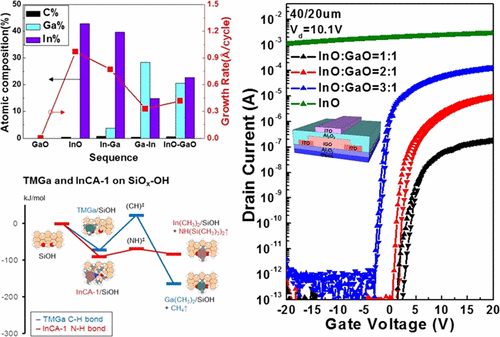当前位置:
X-MOL 学术
›
ACS Appl. Mater. Interfaces
›
论文详情
Our official English website, www.x-mol.net, welcomes your
feedback! (Note: you will need to create a separate account there.)
Atomic Layer Deposition of an Indium Gallium Oxide Thin Film for Thin-Film Transistor Applications
ACS Applied Materials & Interfaces ( IF 8.3 ) Pub Date : 2017-07-05 00:00:00 , DOI: 10.1021/acsami.7b04985 Jiazhen Sheng 1 , Eun Jung Park 2 , Bonggeun Shong 2 , Jin-Seong Park 1
ACS Applied Materials & Interfaces ( IF 8.3 ) Pub Date : 2017-07-05 00:00:00 , DOI: 10.1021/acsami.7b04985 Jiazhen Sheng 1 , Eun Jung Park 2 , Bonggeun Shong 2 , Jin-Seong Park 1
Affiliation

|
Indium gallium oxide (IGO) thin films were deposited via atomic layer deposition (ALD) using [1,1,1-trimethyl-N-(trimethylsilyl)silanaminato]indium (InCA-1) and trimethylgallium (TMGa) as indium and gallium precursors, respectively, and hydrogen peroxide as the reactant. To clearly understand the mechanism of multicomponent ALD growth of oxide semiconductor materials, several variations in the precursor–reactant deposition cycles were evaluated. Gallium could be doped into the oxide film at 200 °C when accompanied by an InCA-1 pulse, and no growth of gallium oxide was observed without the simultaneous deposition of indium oxide. Density functional theory calculations for the initial adsorption of the precursors revealed that chemisorption of TMGa was kinetically hindered on hydroxylated SiOx but was spontaneous on a hydroxylated InOx surface. Moreover, the atomic composition and electrical characteristics, such as carrier concentration and resistivity, of the ALD-IGO film were controllable by adjusting the deposition supercycles, composed of InO and GaO subcycles. Thus, ALD-IGO could be employed to fabricate active layers for thin-film transistors to realize an optimum mobility of 9.45 cm2/(V s), a threshold voltage of −1.57 V, and a subthreshold slope of 0.26 V/decade.
中文翻译:

薄膜晶体管应用的铟镓氧化物薄膜的原子层沉积
使用[1,1,1-三甲基-N-(三甲基甲硅烷基)硅氨基]铟(InCA-1)和三甲基镓(TMGa)作为铟和镓的前驱物,通过原子层沉积(ALD)沉积氧化铟镓(IGO)薄膜。分别与过氧化氢作为反应物。为了清楚地了解氧化物半导体材料的多组分ALD生长机理,对前驱物-反应物沉积循环的几种变化进行了评估。在伴随InCA-1脉冲的情况下,可以在200°C的温度下将镓掺杂到氧化膜中,并且在没有同时沉积氧化铟的情况下,未观察到氧化镓的生长。对前体初始吸附的密度泛函理论计算表明,TMGa的化学吸附在羟基化SiO x上受动力学阻碍。但在羟基化的InO x表面上是自发的。而且,通过调节由InO和GaO子循环组成的沉积超循环,可以控制ALD-IGO膜的原子组成和电学特性,例如载流子浓度和电阻率。因此,可以使用ALD-IGO来制造用于薄膜晶体管的有源层,以实现9.45cm 2 /(V s)的最佳迁移率,-1.57V的阈值电压和0.26V /十倍的亚阈值斜率。
更新日期:2017-07-05
中文翻译:

薄膜晶体管应用的铟镓氧化物薄膜的原子层沉积
使用[1,1,1-三甲基-N-(三甲基甲硅烷基)硅氨基]铟(InCA-1)和三甲基镓(TMGa)作为铟和镓的前驱物,通过原子层沉积(ALD)沉积氧化铟镓(IGO)薄膜。分别与过氧化氢作为反应物。为了清楚地了解氧化物半导体材料的多组分ALD生长机理,对前驱物-反应物沉积循环的几种变化进行了评估。在伴随InCA-1脉冲的情况下,可以在200°C的温度下将镓掺杂到氧化膜中,并且在没有同时沉积氧化铟的情况下,未观察到氧化镓的生长。对前体初始吸附的密度泛函理论计算表明,TMGa的化学吸附在羟基化SiO x上受动力学阻碍。但在羟基化的InO x表面上是自发的。而且,通过调节由InO和GaO子循环组成的沉积超循环,可以控制ALD-IGO膜的原子组成和电学特性,例如载流子浓度和电阻率。因此,可以使用ALD-IGO来制造用于薄膜晶体管的有源层,以实现9.45cm 2 /(V s)的最佳迁移率,-1.57V的阈值电压和0.26V /十倍的亚阈值斜率。


















































 京公网安备 11010802027423号
京公网安备 11010802027423号